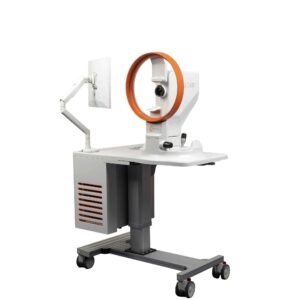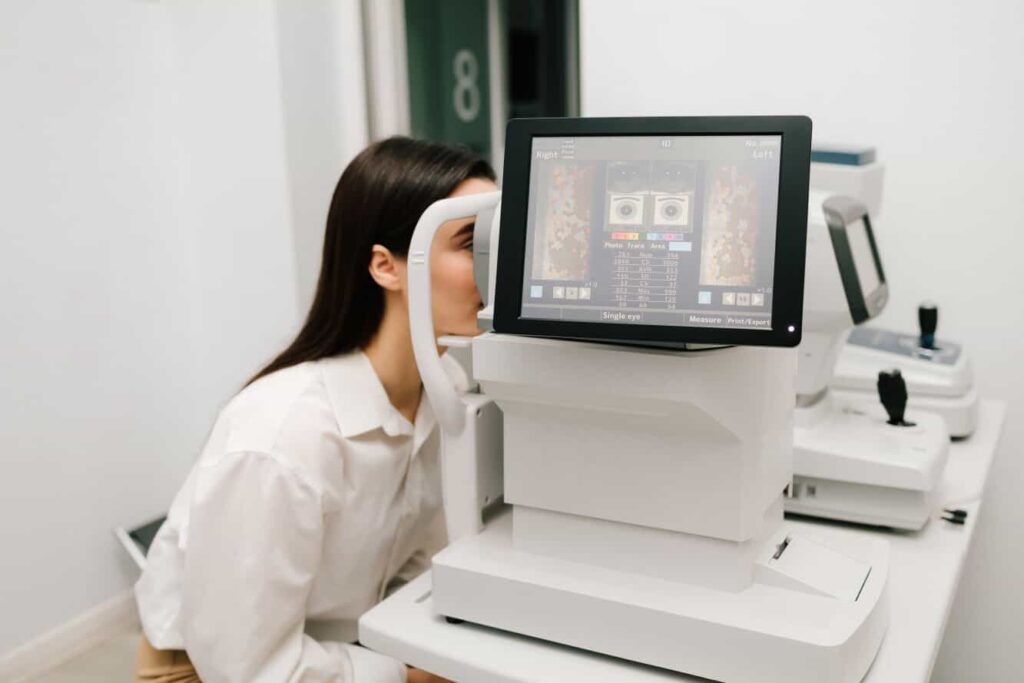In 2025, OCT machines for eye care will evolve from a diagnostic tool to a strategic asset. Imagining needs have shifted: retinal disease is surging, patient volume is climbing, and clinics are expected to diagnose faster and more accurately than ever. Conditions like age-related macular degeneration (AMD) and diabetic retinopathy are projected to affect nearly half a billion people globally within two decades. Clinics that rely on outdated imaging systems risk diagnostic delays that compromise care.
If you’re an ophthalmologist, optometrist, or clinical decision-maker, this is your moment to reassess. We have carefully selected the optical coherence tomography devices in this guide based on performance that holds up in the field. That means faster scans, clearer layers, smarter software, seamless EMR integration, and reliability under pressure.
You’ll find systems built for high-volume glaucoma care, AI-augmented retinal imaging, and versatile setups for mixed-use practices.
See which device leads the pack—#1 might surprise you.
What Is OCT and Why Does It Matter in 2025
Optical Coherence Tomography (OCT) is a non-invasive imaging method that captures high-resolution, cross-sectional scans of ocular tissue. Light waves rather than sound or radiation reveal microstructural layers of the retina, macula, optic nerve, and anterior segment in precise detail.
If you’re evaluating eye care diagnostic tools for 2025, OCT delivers what direct visualization can’t:
- Insight into subclinical changes
- Side-by-side scan comparisons
- Longitudinal tracking across visits
It detects glaucoma, diabetic macular edema, and AMD often before symptoms surface.
With AI systems now interpreting OCT scans at accuracy levels exceeding 91% and diagnostic autonomy becoming critical in primary and specialty care, OCT has moved from helpful to essential. The systems we’ll look at below are five of the best OCT machines in 2025, engineered to match the diagnostic speed, software intelligence, and clinical adaptability this decade demands.
Top 5 OCT Machines in 2025
1. Topcon DRI OCT Triton ($8,999.00)
The Topcon DRI OCT Triton is built for depth and clarity if your clinic handles complex retina cases. Its swept-source technology scans deeper into the choroid (even through dense cataracts or hemorrhages) without sacrificing image quality. For AMD management, diabetic retinopathy tracking, and vitreoretinal diagnostics, Triton consistently delivers high-resolution, cross-sectional imaging.
A built-in color fundus camera and multimodal capture streamline imaging workflows and let you overlay structural data with visible fundus detail in one session.

- Key Features: Swept-source OCT (1,050 nm), multimodal imaging with color fundus overlay, 100,000 A-scans/sec for rapid acquisition
- Strengths: Penetrates dense media with stable image output, visualizes deep choroidal structures with high axial resolution, efficient capture across multiple modalities
- Ideal For: Retina-focused clinics, AMD specialists, vitreoretinal surgeons
- ROI Insight: Fewer repeat scans, faster technician workflows, and increased patient throughput
2. Zeiss CIRRUS 6000 ($19,999.00)
For clinics managing glaucoma and diabetic retinopathy at scale, the CIRRUS 6000 delivers speed with surgical accuracy. At 100,000 A-scans per second, it captures high-density retinal and nerve layer detail—crucial for tracking microstructural changes over time.
The AngioPlex OCTA visualizes retinal vasculature without dye, while AI-driven change maps and auto-centering streamline diagnostics. Full EMR integration through the Zeiss ecosystem supports consistent, team-wide decision-making.

“The CIRRUS 6000 is all about its speed. With increased speed comes greatly improved resolution and detail on cube, raster, and OCTA scans… [It] enables me to incorporate these more reliable scans into my daily workflow and make important patient treatment decisions.”
—Dr. Theodore Leng, MD, FACS, Byers Eye Institute at Stanford
- Key Features: 100k A-scan speed, AngioPlex OCTA, AI-guided change analysis
- Strengths: Fast image acquisition, seamless EMR integration, dye-free vascular imaging
- Ideal For: Optometry and ophthalmology clinics managing chronic retinal and nerve-layer diseases
- ROI Insight: Cuts exam time, reduces technician load, and improves longitudinal care tracking
3. Heidelberg Spectralis OCT2 ($12,999.00)
For clinics where accuracy over time is critical, the SPECTRALIS OCT2 offers unmatched scan-to-scan consistency. Its dual-beam eye tracking locks onto the same retinal location during every scan—essential for monitoring progressive diseases like AMD and diabetic retinopathy. The 85,000 Hz scan rate ensures rapid capture, while multimodal add-ons expand its utility from structural imaging to angiography and autofluorescence.
The platform also integrates Heidelberg’s HEYEX software suite, offering powerful longitudinal tracking and comparative analysis—ideal for clinicians who rely on ultra-consistent data to guide treatment over time.

- Key Features: 85k Hz scan speed, 6μm resolution, multimodal stack, TruTrack™ eye tracking
- Strengths: Longitudinal image consistency, high-speed capture, robust analysis software
- Ideal For: Research-forward clinics, AMD specialists, practices requiring ultra-precise follow-up
- ROI Insight: Reduced motion artifacts and exam time—more patients, less variability
4. Optovue Solix ($45,999.00)
For clinics ready to scale services or adopt AI-powered eye care diagnostics, the Optovue Solix offers advanced functionality in a single compact system. With ultra-high-speed scanning (up to 120,000 A-scans per second), it captures both posterior and anterior segment images in one pass. Widefield 3D OCTA provides vascular detail without dye and its AI-based tools flag pathologies early with minimal technician input.

True-color fundus imaging adds an intuitive visual layer for real-time diagnostics, while Solix’s integrated platform minimizes the need for multiple devices or software workarounds.
- Key Features: 120k A-scan speed, 2-in-1 posterior/anterior imaging, 3D widefield OCTA
- Strengths: AI-assisted workflows, true-color fundus, compact all-in-one design
- Ideal For: Practices expanding diagnostic services without expanding hardware
- ROI Insight: Fewer devices, faster workflows, and scalable service lines
5. Canon Xephilio OCT-S1 ($25,999.00)
If you need widefield clarity without minimal setup, the Xephilio OCT-S1 delivers. This swept-source OCT machine for eye care captures a 23mm widefield scan in a single pass, providing retina-to-choroid visualization in one view. Its dual mode operation (mydriatic and non-mydriatic) keeps throughput high across different patient types.
Designed as a portable OCT machine for small clinics, the OCT-S1 excels in tight spaces and mobile setups. Its intuitive interface reduces training time, and rapid boot-up enables same-day scans without delay, making it ideal for unpredictable patient flow or decentralized care models.

- Key Features: Widefield SS-OCT, 23mm scan width, auto-alignment, mydriatic/non-mydriatic modes
- Strengths: True single-capture widefield, minimal learning curve, fast setup
- Ideal For: Small or multi-use clinics, mobile/satellite locations, generalist workflows
- ROI Insight: Fewer retakes, lower training overhead, and versatile placement across locations
OCT Machine Comparison Table
Here’s how the best OCT machines for eye care in 2025 stack up. Use this table to compare what matters most in your clinic, from scan speed to software suite.
Need help interpreting the specs? Our diagnostic specialists can walk you through each.
| Model | Scan Speed | Imaging Depth | Angiography | Software | OCT Machine Price Range |
| Zeiss CIRRUS 6000 | 100,000 A-scans/sec | 2.9 mm | AngioPlex OCTA | FORUM, GPA, Retina Workplace | $49k–$55k |
| Heidelberg Spectralis OCT2 | 85,000 A-scans/sec | 1.9 mm | Heidelberg OCTA (optional) | HEYEX 2, Glaucoma/Retina Modules | $15k–$51k |
| Canon Xephilio OCT-S1 | 100,000 A-scans/sec | 5.3 mm | OCTA | Retina and Glaucoma modules | Contact Saturn Optical |
| Optovue Solix FullRange | 120,000 A-scans/sec | 6.25 mm | AngioVue OCTA | NetVue Pro Review | $46k–$67k |
| Topcon DRI OCT Triton | 100,000 A-scans/sec | Optical: 8 μm, digital: 2.6 μm (axial resolution) | OCTARA SS-OCT Angio | IMAGEnet® 6, PinPoint™, PixelSmart™ | $48k–$59k |
How to Choose the Right OCT for Your Clinic
There’s no one-size-fits-all OCT. What works for a high-volume retina practice may overwhelm a smaller clinic focused on early glaucoma detection. Consider your patient load, diagnostic priorities, staff expertise, and whether AI-enhanced workflows fit your roadmap.
At Saturn Optical, we match clinics with devices that suit their realities. Whether you need deeper scans, faster throughput, or streamlined software, we can help you find the right fit. Every OCT machine featured in this guide is available through Saturn Optical, which is backed by expert consultation, full training, and responsive post-sale support.
Explore our buyer’s guide or schedule a one-on-one consultation.
Remember to bookmark this guide—we update it quarterly with new data.
Final Thoughts: Which OCT Fits Your Needs?
Every clinic has a different pulse. Here’s how the top contenders align:
- Topcon Triton: Best for retina specialists who need deep choroidal detail with minimal retakes.
- Zeiss CIRRUS 6000: Ideal for high-throughput glaucoma care and AI-guided progression tracking.
- Heidelberg Spectralis OCT2: Precision-first imaging for practices managing chronic retinal disease.
- Optovue Solix: A compact, AI-forward platform for clinics scaling diagnostics smartly.
- Canon Xephilio OCT-S1: Versatile widefield imaging for multi-use and satellite setups.
The reason to invest in the best OCT isn’t the one with the longest spec sheet—it’s the one that fits how your clinic runs.
Explore our OCT machines for eye care at Saturn Optical and see which one fits your practice best.
FAQ: OCT Buying in 2025
What is the best OCT machine for retinal diagnostics in 2025?
For deep choroid, choose Triton. For precision tracking, Spectralis. For diabetic retinopathy, CIRRUS 6000 with AI progression maps.
How much does an OCT machine cost in 2025?
OCT machine prices range from $15K to $100K+. The cost depends on scan speed, depth, angiography, and AI tools.
Are AI-powered OCT systems worth it for small clinics?
Yes, if they cut retakes, reduce scan time, or simplify decisions. But only when AI matches actual workflow needs.
